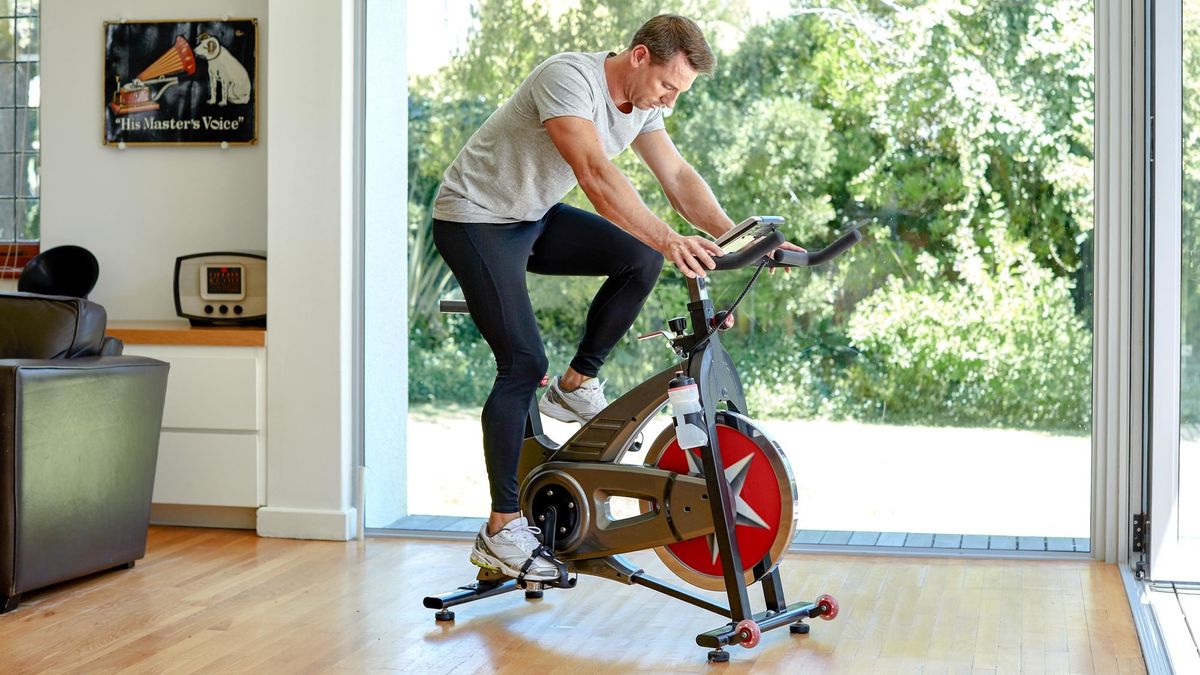Stationary cycling is a great way to get a low-impact cardio workout, but not all stationary bikes are built the same. If you’ve just begun a fitness routine, you may compare recumbent vs. upright exercise bikes and wonder if one is ‘better’ to use than the other.
As is the case with most pieces of workout equipment, recumbent bikes and upright bikes both have their benefits and drawbacks. The best exercise bike for you will depend on factors like your health and wellness goals, current injuries or considerations, and personal preferences.
Below you’ll learn the differences between recumbent bikes and exercise bikes, and how to determine which you should choose. No matter what you decide, it’s important to remember that either type of bike can provide an effective and efficient workout.
What is an upright exercise bike?
Upright exercise bikes closely resemble actual bicycles with the rider seated upright on a saddle and the pedals located underneath the hips. Force is applied onto the pedals in a downward circular motion which works the quadriceps, hamstrings, and glute muscles.
Resistance can be added to the pedals in different ways depending on the model of upright exercise bike. Most standard upright bikes allow the rider to adjust the resistance levels through controls on the display panel. Resistance on spin bikes can be altered by turning a knob located on the bike’s frame.
Upright exercise bike riders should keep their core muscles engaged and spine in a neutral position while pedaling. Hands should be placed on the front handle bars for light support and balance.
Some upright bikes are designed so that the rider can lift themselves off of the saddle while they pedal, but the same attention should be paid to form — the core should remain engaged and the spine neutral.
The most famous example of an upright exercise bike is the Peloton Bike+ which has the classic pedals-under-hips design but with a large display in front of the handlebar so you can access the brand’s live and on-demand streamed classes.
For a more traditional option, there’s the Sunny Health & Fitness Indoor Cycle Bike available at a fraction of the cost of Peloton, but without the smart features.
What is a recumbent exercise bike?
Unlike upright bikes, recumbent bikes are designed so that the rider is seated in a reclined position. The pedals are located directly across from the hips, and force is applied in a forward circular motion working the quadriceps, hamstrings and glues.
Most recumbent bikes — including our favorite, the Schwinn 270 Recumbent Bike — feature a full seat with a backrest as opposed to a saddle. Resistance can be added to the recumbent bike’s pedals by adjusting controls on the display.
Even though the majority of recumbent bikes have a seat back to provide support, riders should still be mindful of keeping their spine in a neutral position throughout the workout.
Who should use a recumbent bike?
Recumbent bikes are an excellent choice for beginners, for those with chronic joint or back pain, for those rehabilitating from injury, and for seniors.
Their design is generally more comfortable than upright bikes, requiring less core and upper body strength to operate safely. Since recumbent bike seats are usually wider with a full seat back, there’s less pressure placed on the rider’s tailbone and greater structural support for the lower back.
They’re much easier to mount and dismount than an upright exercise bike, making them more accessible for wheelchair users or those with mobility limitations. And if you want to develop strength in your lower body, recumbent bikes are a great option.
According to a study in the International Journal of Sports Physical Therapy, pedaling on a recumbent bike resulted in greater activity of the semitendinosus (a muscle in the hamstring) and the tibialis anterior (a muscle in the shin).
Additionally, recumbent bikes are great for those who are shorter than average in height. If you have to lean forward excessively in order to reach an upright exercise bike’s handle bars, you might want to try a recumbent bike instead.
Is an upright bike better than a recumbent?
Both upright and recumbent exercise bikes are capable of providing the kind of moderate-intensity aerobic exercise that would help you meet the U.S. CDC’s recommendations.
However, upright bikes do have an advantage when it comes to total muscle recruitment. Riding an upright exercise bike not only requires lower body work, but also core and upper body work as well. Generally, recumbent bikes only activate lower body muscle groups.
Upright bikes also offer a bit more workout versatility as riders can choose to stand and pedal out of the saddle. This position often increases the demands on your cardiovascular system, and can require even greater effort from your lower body, upper body, and core.
Since upright exercise bikes require work from more muscle groups, you might assume they burn more calories too. This isn’t necessarily the case, though. Calorie burn is largely dependent on the intensity of your workout, so a leisurely ride on an upright bike could burn fewer calories than a vigorous ride on a recumbent bike.
Recumbent vs upright exercise bikes: which is right for you?
When trying to determine whether an upright or recumbent exercise bike is the right choice for you, you’ll want to keep a few factors in mind.
First, think about your overall fitness goals and any current injuries or considerations. If you’re training for a cycling race or an endurance event like a marathon, an upright bike would be the best decision. If you have an acute lower back injury or you’re limited in mobility, a recumbent bike would be the safest choice.
If you’re just looking to improve your cardiovascular health or lose a few pounds, either bike would be appropriate. In fact, there’s no reason you can’t incorporate both upright cycling and recumbent cycling into your routine.
More from Tom’s Guide
Source link
